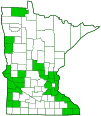Leonard’s skipper
(Hesperia leonardus)
Conservation • Description • Habitat • Ecology • Distribution • Taxonomy
Conservation Status |
|
|||||||
| IUCN Red List | not listed |
|||||||
| NatureServe | N4 - Apparently Secure S3 - Vulnerable |
|||||||
| Minnesota | Special Concern Species in Greatest Conservation Need |
|||||||
Description |
||
Leonard’s skipper is a large, late season, branded skipper. It occurs in North America east of the Rocky Mountains. It is listed as a Special Concern species in Minnesota, where it is declining due to habitat loss, insecticide drift from nearby croplands, and prescribed burning of managed prairies and savannas. There are three subspecies of Leonard’s skipper, two of which occur in Minnesota. The western subspecies, Pawnee skipper (Hesperia leonardus pawnee), is found in prairies in the west. The eastern subspecies, Leonard’s skipper (Hesperia leonardus leonardus), is found in dry prairies, savannas, open woodlands, and woodland openings in the east. The ranges of the subspecies overlap in eastern Minnesota, western Iowa, and western Wisconsin. In these areas the subspecies interbreed, producing “blended” offspring that are closer in appearance to Leonard’s skipper. The Leonard’s skippers in eastern Minnesota are all or mostly “blended”. Adults fly from early August to mid-September. They feed on nectar from many flowers, especially blazing stars in the west and New England aster in the east, but also on other asters, wild bergamot, heal-all, round-headed bush clover, goldenrods, spotted knapweed, prairie ironweed, thistles, Joe-pye weed, and sunflowers. Larva feed on grasses. Adults have a 1¼″ to 1¾″ (32 to 45 mm) wingspan. On the male the forewings are angular and narrow. The upper side of the forewing on the male is reddish-orange with broad black borders. Near the middle of the wing there is a narrow, pointed area of black, specialized, scent scales (stigma). This is the “brand” that gives the genus its common name. On the female the basal area is darker and there is a row of squarish, orangish-yellow spots. As with many skippers, there is also a row of three small pale spots, the “wrist bracelet”, near the costal margin in the subapical area. The upper side of the hind wing on both sexes has a row of orangish-yellow spots. The underside of both wings is rust-red. On the hind wing there is a row of prominent light brownish-yellow or white spots. The antennae are short and barred. Each antenna has a swelling (club) at the tip, and a pale, thin, hooked extension (apiculus) at the end of the club. There is not a white band below the club. |
||
Size |
||
Wingspan: 1¼″ to 1¾″ (32 to 45 mm) |
||
Similar Species |
||
Habitat |
||
Leonard’s skipper: dry prairies, savannas, open woodlands, and woodland openings Pawnee skipper: prairies |
||
Ecology |
||
Season |
||
One generation per year: early August to mid-September |
||
Behavior |
||
Leonard’s skipper is a fast flier. In flight the wings appear as a blur. |
||
Life Cycle |
||
First stage (instar) larvae overwinter. They continue feeding in the spring and pupate in July. Adults emerge in August. |
||
Larva Hosts |
||
Grasses |
||
Adult Food |
||
Nectar from many flowers, especially blazing stars in the west and New England aster in the east, but also on other asters, wild bergamot, heal-all, round-headed bush clover, goldenrods, spotted knapweed, prairie ironweed, thistles, Joe-pye weed, and sunflowers. |
||
Distribution |
||||
|
Sources |
|||
| 6/3/2022 | ||||
Occurrence |
||||
Uncommon in Minnesota |
||||
Taxonomy |
|||
Order |
Lepidoptera (Butterflies and Moths) | ||
Superfamily |
Papilionoidea (butterflies) | ||
Family |
Hesperiidae (skippers) | ||
Subfamily |
Hesperiinae (grass skippers) | ||
Tribe |
Hesperiini | ||
| Subtribe | Hesperiina (branded grass skippers) | ||
Genus |
Hesperia (branded skippers) | ||
Subordinate Taxa |
|||
Leonard’s skipper (Hesperia leonardus leonardus) Pawnee Montane skipper (Hesperia leonardus montana) Pawnee skipper (Hesperia leonardus pawnee) |
|||
Skippers have traditionally been placed in their own superfamily Hesperioidea because of their morphological similarity. Recent phylogenetic analysis (Kawahara and Breinholt [2014]) suggests that they share the same common ancestor as other butterfly families, and thus belong in the superfamily, Papilionoidea. |
|||
Synonyms |
|||
|
|||
Common Names |
|||
Leonard’s skipper |
|||
Glossary
Apiculus
A thin hooked or pointed extension at the ends of each antenna just beyond the club of all skippers except skipperlings (subfamily Heteropterinae).
Costal margin
The leading edge of the forewing of insects.
Instar
The developmental stage of arthropods between each molt; in insects, the developmental stage of the larvae or nymph.
Stigma
In plants, the portion of the female part of the flower that is receptive to pollen. In Lepidoptera, an area of specialized scent scales on the forewing of some skippers, hairstreaks, and moths. In other insects, a thickened, dark, or opaque cell on the leading edge of the wing.
Visitor Photos |
|||||
Share your photo of this insect. |
|||||
| This button not working for you? Simply email us at info@MinnesotaSeasons.com. Attach one or more photos and, if you like, a caption. |
|||||
Nancy Falkum |
|||||
Golden Rod with Leonard’s Skipper |
|||||
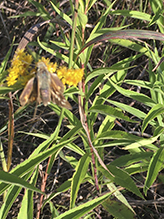 |
|||||
Blazing Star, Rough Liatris aspera w/Hesperia leonardus Leonard’s Skipper |
|||||
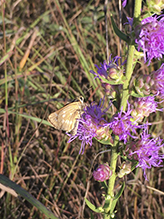 |
|||||
Scott Leddy |
|||||
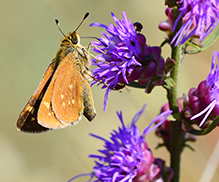 |
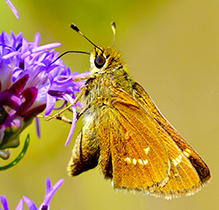 |
||||
MinnesotaSeasons.com Photos |
|||||
|
|||||

Visitor Videos |
|||
Share your video of this insect. |
|||
| This button not working for you? Simply email us at info@MinnesotaSeasons.com. Attach a video, a YouTube link, or a cloud storage link. |
|||
Other Videos |
|||
| Leonard's Skipper Butterfly Laurett Garden |
|||
About
Jan 11, 2021 Found this butterfly eating nectar from my purple coneflower. |
|||
| Late Flying Skippers Dick Walton |
|||
About
Apr 18, 2011 Leonard's Skipper and Common Branded Skipper |
|||


Created: 5/11/2021
Last Updated:
